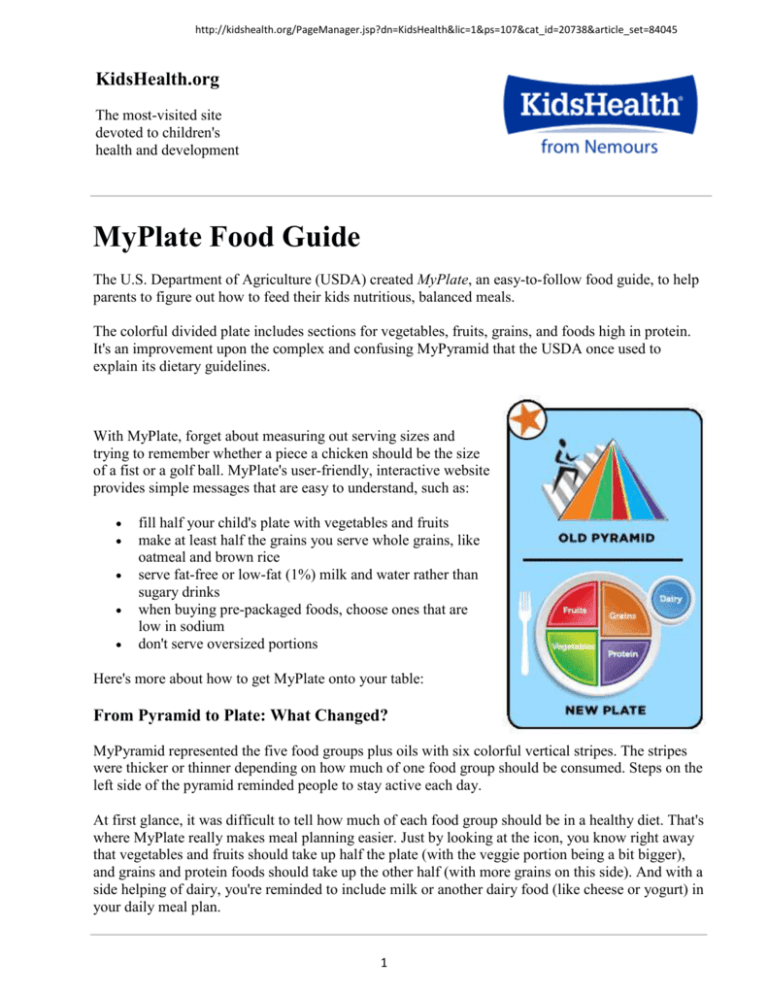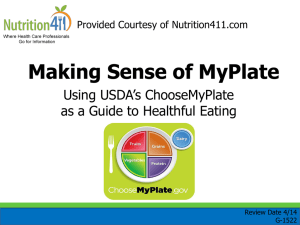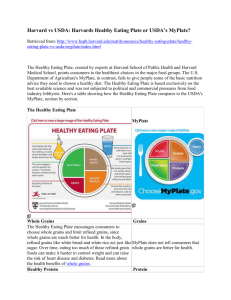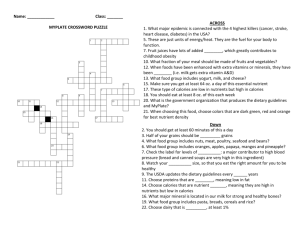
http://kidshealth.org/PageManager.jsp?dn=KidsHealth&lic=1&ps=107&cat_id=20738&article_set=84045
KidsHealth.org
The most-visited site
devoted to children's
health and development
MyPlate Food Guide
The U.S. Department of Agriculture (USDA) created MyPlate, an easy-to-follow food guide, to help
parents to figure out how to feed their kids nutritious, balanced meals.
The colorful divided plate includes sections for vegetables, fruits, grains, and foods high in protein.
It's an improvement upon the complex and confusing MyPyramid that the USDA once used to
explain its dietary guidelines.
With MyPlate, forget about measuring out serving sizes and
trying to remember whether a piece a chicken should be the size
of a fist or a golf ball. MyPlate's user-friendly, interactive website
provides simple messages that are easy to understand, such as:
fill half your child's plate with vegetables and fruits
make at least half the grains you serve whole grains, like
oatmeal and brown rice
serve fat-free or low-fat (1%) milk and water rather than
sugary drinks
when buying pre-packaged foods, choose ones that are
low in sodium
don't serve oversized portions
Here's more about how to get MyPlate onto your table:
From Pyramid to Plate: What Changed?
MyPyramid represented the five food groups plus oils with six colorful vertical stripes. The stripes
were thicker or thinner depending on how much of one food group should be consumed. Steps on the
left side of the pyramid reminded people to stay active each day.
At first glance, it was difficult to tell how much of each food group should be in a healthy diet. That's
where MyPlate really makes meal planning easier. Just by looking at the icon, you know right away
that vegetables and fruits should take up half the plate (with the veggie portion being a bit bigger),
and grains and protein foods should take up the other half (with more grains on this side). And with a
side helping of dairy, you're reminded to include milk or another dairy food (like cheese or yogurt) in
your daily meal plan.
1
http://kidshealth.org/PageManager.jsp?dn=KidsHealth&lic=1&ps=107&cat_id=20738&article_set=84045
Because MyPlate is a divided plate, no one food group overpowers the others. That's because dietary
guidelines encourage eating a variety of foods and discourage "super-sized" portions, which can lead
to weight gain and obesity.
Although the food guide icon has changed, the USDA's message about eating well has stayed the
same. Kids still need to eat lots of fruits, vegetables, and whole grains, along with lean meats or other
forms of protein and low-fat dairy products.
Oils provide important nutrients and are recommended in small amounts but aren't included on the
MyPlate icon. Choose oils over solid fats, but limit the amount you eat.
Exercise is no longer included in the icon, but it's still an important component of a healthy lifestyle.
Starting when they're 2 years old, kids need at least 60 minutes of moderate to physical activity each
day.
How to Make MyPlate Yours
Once you get the concept of MyPlate down, you might be wondering: Do I have to serve all the food
groups at each meal? And what about breakfast? Do I really have to give my kids veggies for
breakfast? After all, it might be hard enough to get them to eat them at lunch or dinner.
No, you don't, but do aim to serve a variety of food groups at each meal. Use the plate as a guide
when planning and serving meals. And if breakfast or lunch doesn't include a veggie or fruit, serve
one of those at snack time (yes, portion-controlled snacks are still a good idea!).
The goal is to think of the plate as an entire day's worth of eating: so, throughout the day, try to
make half of what your kids eat vegetables and fruits, and the other half grains and protein foods. An
occasional treat is fine, but be careful to limit foods that are high in calories and low in nutrients.
If you're thinking it might be difficult to get your kids to take a bite off this new plate, practice what
you preach. MyPlate is not just for kids, but for adults, too. Kids who see their parents eating better
are more likely to do so themselves.
Green = Vegetables
The vegetable portion of MyPlate, in green, is one of the largest portions on the plate. That's because,
just like grandma said, it's important to "eat your veggies!"
Vegetables provide many of the vitamins and minerals kids need for good health, are naturally low in
calories, and contain fiber. The vegetable group is divided into five subgroups based on their
nutrients:
1. dark green vegetables (like broccoli, spinach, and kale)
2. orange and red vegetables (like squash, carrots, and sweet potatoes)
3. beans and peas (like kidney beans, lentils, and black-eyed peas — also included in the protein
group)
4. starchy vegetables (like corn, potatoes, and plantains)
5. other vegetables (those that don't fall into a particular nutritional category, like artichokes and
avocado)
2
http://kidshealth.org/PageManager.jsp?dn=KidsHealth&lic=1&ps=107&cat_id=20738&article_set=84045
For best nutritional value, serve a variety of vegetables to your family each week. Vegetables can be
prepared and served in any number of ways and you can use fresh, frozen, dried/dehydrated, or
canned veggies.
Red = Fruits
Fruits take up a slightly smaller portion of the plate than vegetables, but they're still an important part
of a diet. They contain necessary nutrients like vitamin C, potassium, and fiber. Great choices
include oranges, peaches, mangoes, strawberries, and apples.
Serve fruit a variety of ways: whole, cut up, in smoothies. When buying canned fruit, choose fruit
that is packed in juice rather than heavy or light syrup. And it's best to serve whole fruit over 100%
fruit juice, as some nutrients are lost in the juicing process.
Orange = Grains
The grain group includes any food made from wheat, oats, cornmeal, barley, or other grain. Bread,
tortillas, cereal, rice, and pasta belong in this group.
At least half of the grains kids eat each day should be whole grains, such as oatmeal, brown rice, and
whole wheat. Whole grains have dietary fiber that helps you feel full and protects against
constipation. Eating a diet rich in whole grains also might decrease the risk of developing heart
disease and diabetes.
Whole grains are different from refined grains, such as those in white bread and white rice, which
have been processed and had many of their nutrients removed. Most refined grains are enriched,
which means that nutrients, except fiber, are added back after processing.
Purple = Protein Foods
Foods that are high in protein help the body build, maintain, and repair tissue. They also have
nutrients that are necessary to the body, like B vitamins and iron.
Protein-rich foods include beef, poultry, seafood, dry beans and peas, eggs, nuts, and seeds. Soy
products like tofu and veggie burgers are also good sources of protein. When eating meats, choose
lean or low-fat options and try to minimize deli meats and other processed meats that are high in
sodium.
Blue = Dairy
This group includes milk and other dairy products that retain their calcium content, such as yogurt
and cheese. Calcium-fortified soy milk is also included in the dairy group. Besides providing
calcium, dairy products are important sources of vitamin D and protein. Vitamin D helps the body
absorb calcium and use it for healthy bones and teeth.
Serve low-fat or nonfat milk and dairy products to kids over 2 years old.
3
http://kidshealth.org/PageManager.jsp?dn=KidsHealth&lic=1&ps=107&cat_id=20738&article_set=84045
Oils: No Longer on the Guide
Oils were included in the Food Guide Pyramid because of the essential nutrients they provide, but
you won't find them on the plate. Still, it's important to know about oils, which are fats that are liquid
at room temperature.
Most oils (like cooking oils, such as olive oil, corn oil, or canola oil, and oil-rich foods like nuts,
olives, and avocados) are high in what's considered "good" fats: monounsaturated or polyunsaturated
fats. These fats raise (good) HDL cholesterol, which helps prevent heart problems, and maintain
healthy levels of (bad) LDL cholesterol, which can lead to heart problems if elevated. It's good to
incorporate a small amount of these types of oils into your diet.
On the other hand, solid fats (like butter, shortening, and margarine) contain more saturated fats
and/or trans fats ("bad fats") than most oils, and should be limited. Some oils, including coconut oil
and hydrogenated oils, are high in saturated or trans fats and are considered solid fats. Consuming
large amounts of saturated and trans fats has been shown to raise LDL cholesterol levels in the blood
and increase the risk for heart disease.
Customize Your Plate
MyPlate should be seen as a guide for healthy eating, and not a one-size-fits-all solution for
everybody. Depending on a child's need, some food groups will need to be increased and others
decreased. Talk to your health care provider to find out what's best for your kids.
The USDA's website offers food suggestions and tips, portion guidelines by age, and interactive tools
to help you make MyPlate yours. Visit online at ChooseMyPlate.gov. [Please note: By clicking on
this link, you will be leaving our site.]
Reviewed by: Mary L. Gavin, MD
Date reviewed: July 2014
Note: All information on KidsHealth® is for educational purposes only. For specific medical advice,
diagnoses, and treatment, consult your doctor.
© 1995-2014 The Nemours Foundation. All rights reserved.
Images provided by The Nemours Foundation, iStock, Getty Images, Corbis, Veer, Science Photo
Library, Science Source Images, Shutterstock, and Clipart.com
4







